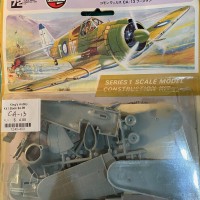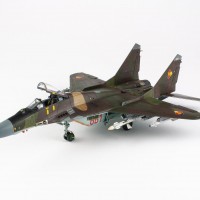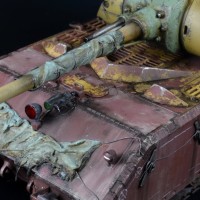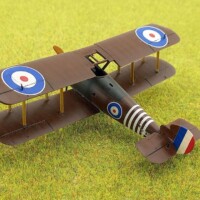Review: Flying brick, French style – Azur 1/72 Bloch 210
Introduction
French interwar bombers have always had a certain charm. The stubborn drive to ignore the principle of aerodynamics and a certain ugly charm make them winners to my mind. So, when Azur announced a Bloch 210 I was very interested. The only previous kit was the Heller version which was more than a bit long in the tooth so a new kit was overdue.
History
The Bloch 210 was basically an interim bomber following on from the Bloch 200 but introducing several innovations (rectractable undercarriage, low wing etc.) Like the Bloch 200 it was initially powered by Gnome Rhone 14K engines. This engine had been selected as a base engine for the French Air Force. However, Gnome Rhone were better salesmen then engineers. The Armee de l'air was completely sold on the engine but there were certain issues not quite addressed by the company. The oil cooling circuit was poorly designed causing a lack of oil flow during certain stages of the engine performance. In particular, oil flow during take off wasn't sufficient causing the engines to seize with often fatal consequences. Overheating was common. The engines themselves proved to be underpowered for the size of aircraft, an issue only cured with the introduction of the 14N engine which still had issues.
Bloch 210s entered service in September 1936 with GB II/21 then cascaded down to GB II/19, GB I/12 and GB II/12 in early 1937. Initially a 4 seat bomber it was upgraded to 5 seats in November 1936. However, troubles with the aircraft led to the entire fleet being grounded from May 1937 to September 1937 for engine replacement. Certainly the engines were a significant feature of the issues but furthermore, pilots struggled to transition from antiquated biplanes to modern high speed monoplane bombers. In fact, accidents were so frequent that the Bloch 210s earned the unwelcome sobriquet of 'Cercueil Volant' ('flying coffin'). The new Gnome Rhone 14N engines and better training helped and the accident rate fell. Even so the Bloch 210 was considered too slow by 1939 and after several combat losses was relegated to training schools and night bombardment by May 1940.
The kit
The new Azur Frrom kit arrived early this year and is clearly a labour of love. Impressively detailed and well researched it is also well molded with a decal sheet of 3 options per kit. One needs to be clear what is modeled though. This is the Gnome Rhone 14N version and all options are fitted with these engines. If one wants to make one of the Gnome Rhone 14K aircraft (No. 1 to 51) one needs to do some backdating. Some 14K powered aircraft did survive to 1938 and were transferred to the Spanish Republican aircraft so it is surprising that this option was omitted. However, what is available is impressive. The 14N version is accurate and comes with both early cowlings and later cowlings. You get 3D printed early exhausts and excellent later GAL exhausts. Another option is open or closed front entry doors with a separate ladder. Molding is excellent and there is a very useable etched brass sheet included. The instructions are clear and need careful study to make sure one is getting the assembly correct.
Decals
These are a weak point of the aircraft - the options are nicely chosen and I bought the early option kit. I felt that the GB II/21 decals should have been included (this was the 'early' boxing) especially as they came with interesting fuselage stripes. The other two options were very appropriate and the printing of most colours was clear. Where they fell down was poor whites with saturation being marginal (lots of gaps in the white areas) and their fragility and general unresponsiveness. Even after coating with Microscale Decal film they showed a propensity to break up and they responded reluctantly to setting solutions. They were also incomplete - early aircraft carried both the aircraft serial number and aircraft squadron number in small figures on the nose. These came from the spares box. Contacting Gilles of Azur I was told they were printed by Eduard which explains everything (Eduard in-house decals are mediocre). Gilles also mentioned that Azur is exploring switching to Cartograph for decal printing and I hope this comes to fruition. Given the quality of this kit in general it really would be a boost to have top quality decals to go with it.
Building the kit
The kit goes together well but needs time. There is almost too much detail and one needs to follow the instructions and pay attention to the construction sequence. As with every Azur kit a ruthless approach to mold lines is essential and once this is attained one enjoys a smooth construction process with well fitting, well thought out parts. The interior is very detailed with the radio operator and navigator's seats having 4 and 5 parts respectively. This is not a beginner's kit - one needs several kits to ones credit before attempting it. I did replace the pilots seats though - the kit versions seemed a bit crude I also added seatbelts to them. Another addition were the bars for the front gunner/bomb aimer's transparency which were fabricated from 0.3 mm square strip. These do add a lot to the finished result. Painting of the interior is best undertaken before adding the windows which fit very well (after the inevitable clean up). I also scratch built the retraction mechanisms for the dorsal and ventral turrets. Here I recommend the Special Hobby mask set for this kit. It really does help with the glazing and is an excellent fit.
The wing attachment is the typical Azur spar and integral fairing method. As ever allow the spar to float freely and don't cement it. This ensures a nice fit without filler. I only used filler around the transparent parts - the nose front (which is transparent) and cockpit doors. The fuselage also doesn't need it. For the engines I used the kit engines but backdated them to Gnome Rhone 14K engines. In all I added 56 pushrods to the engines (0.4 mm plastic rod), 18 engine bearers (0.3 mm plastic rod) and 6 supports for the baffle plates (0.3 mm plastic rod). These additions really do give pop to the engines. I also fabricated the baffles for the 14K engines. The oil cooler air intakes were cut back as were the engine attachment points. Colours used were Mr Color Metallic Black and Steel. The baffle plates were Mr Color Super Duralumin which produced a very nice bright sheen matching the photos nicely. The engine baffle plates were repurposed wheel covers filed to shape. Early aircraft were fitted with Holt flare holders for night landings and so the wing mounted landing lights need to be blended in and painted over. The kit includes the flare holders but they do need to be wider spaced - an easily accomplished modification.
The etched brass was well thought out and fitted nicely. It really adds detail though there is a lot of it. I did replace the rudder wires with 0.2 mm brass rod and also the rudder trim tabs. The fin flash ended up being hand painted - the width of the stripes did vary between aircraft. I found the blue on the decals was best matched by Gris bleu clair (available from Sovereign Paints) not sky blue. The aircraft was painted in Mr Color H80 (Khaki green) which is a perfect match for the French dark green though one can use Sovereign Paints Vert Fonce as well and satin varnished. Engine sections were Tamiya XF-16 with the propellers being Mr Color Aluminium .Decals were modified for Aircraft No. 5 (Squadron No. V - some French squadrons used Roman numerals and some Arabic numerals) of the 4th Squadron GB II/19 (SPA 79) which is one of the kit options. The rear tail wheel wires were 0.2 mm etched brass rod painted steel. Guns were omitted for my aircraft. It was standard practice for interwar aircraft to fly without them and turrets attached in appropriate orientations. I did scratch build the retraction mechanisms for the dorsal and ventral turrets though and these look very nice through the windows. The kit MAC 34s are excellent replicas though and one can happily include them if one wishes. Bomb crutches were fitted though the bombs were removed. These are also very impressive if one wants a loaded aircraft.
Conclusion
A marvelous kit! The effort that went into getting it right shines through and it stands out as Azur's best effort so far. It's very well detailed and accurate for the version it presents. It also builds well and one just needs to take one's time over the process. At the end of the build you end up with a superb replica relegating the Heller offering to the dustbin of history.










Nice job, Christopher.
Many, many thanks Gary
Ahoy Christopher. I've always been drawn to French airplanes. The French interwar collection of bombers and fighters, to say the least, is interesting. Most were built to changing and conflicting specifications and designed by a committee. When viewing these remarkable airplanes I can't help but say to myself "what were they thinking?" I call for example your Bloch 210 and the Amiot 143. Their look is certainly unique. Your Bloch is a delight. It makes me feel like I just watched a Movietone Newsreel from the '30s. It's hard to believe that the same company that made the Bloch 210 later created the most beautiful airplane in the world, the Mirage III. Great job. Great Model. and Great piece of History. Thank you.
Hi Thomas
Thanks ever so much for the kind comments.
The French had a 'multiplace de combat' philosophy and an inflated view of what a bomber could do. It basically meant bombers were supposed to be able to perform any function. This kind of constrained their designs within a straightjacket of inappropriate requirements. It gave the aircraft a certain ugly charm but was a dead end.
I really like your first paragraph. It says it all about French aviation design policy during that period...especially the part about ignoring basic aerodynamic principle in favor of some design esthetic. And as Thomas Shema (@strongeagle) also said, it seemed as if the varied components of the airplane were designed by a different committee with a different mandate on what the airplane should look like and do. Well done!
Hi Tom
As I mentioned to Thomas the whole French aviation philosophy was a dead end. The amazing thing is that despite looking like it was designed by a committee it was actually designed by one company. Bloch produced several 'disappointments' in the Interwar period.
Yep - I too am intrigued by these odd designs, and have a bunch of them in my stash (including the Heller version of this one)! Looks great!
Thanks very much Greg! I would suggest replacing your Heller version with this one - it is far better.
Fantastic job on a distinctively looking and historically important airplane, Christopher!
Excellent, informative article as well!
Congratulations!
Thanks ever so much Spiros - you are very kind!
That's a wonderful result, Christopher @christopher
French aircraft did have quite a unique look in those years.
Thanks a lot for sharing the historical background, very interesting.
You're very kind John - your comments are really welcome.
Awesome build! I'm a fan of interwar birds - I gotta get one!
Thanks ever so kindly Chas - the kit is an enjoyable build.
Nice work. Only its mother (or you) could love that thing.
Many, many thanks Tom - it's not the worst looking of the French bombers but I do agree.
Very nice build of a french ugliness, Christopher @christopher lovely paintjob!
lovely paintjob!
Thanks ever so much Felix! @fxrob This was a fun build as well
@Christopher immaculate glazing btw!
Thanks once again Felix!